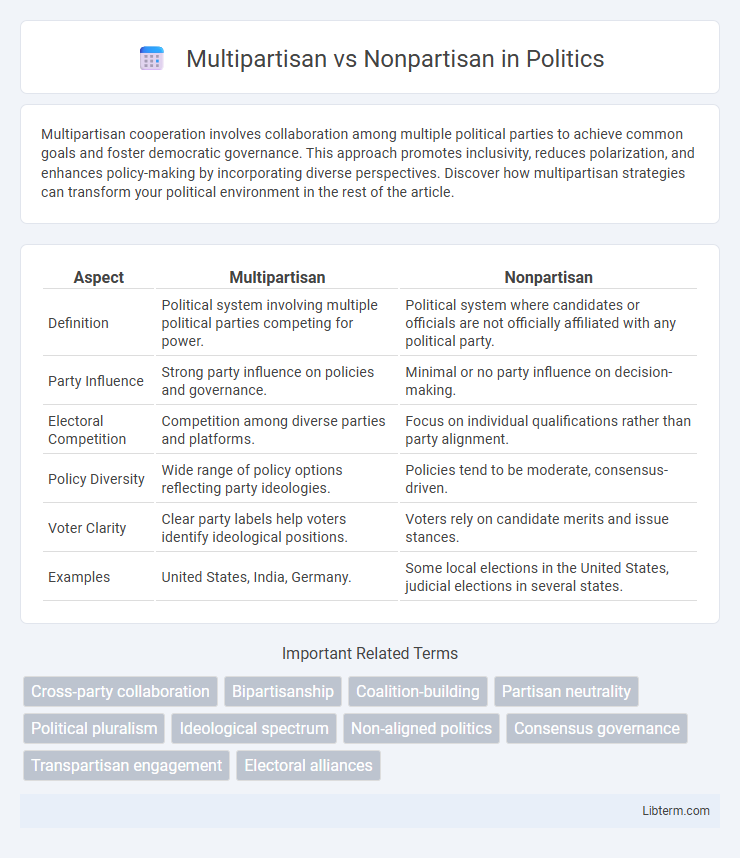Multipartisan cooperation involves collaboration among multiple political parties to achieve common goals and foster democratic governance. This approach promotes inclusivity, reduces polarization, and enhances policy-making by incorporating diverse perspectives. Discover how multipartisan strategies can transform your political environment in the rest of the article.
Table of Comparison
| Aspect | Multipartisan | Nonpartisan |
|---|---|---|
| Definition | Political system involving multiple political parties competing for power. | Political system where candidates or officials are not officially affiliated with any political party. |
| Party Influence | Strong party influence on policies and governance. | Minimal or no party influence on decision-making. |
| Electoral Competition | Competition among diverse parties and platforms. | Focus on individual qualifications rather than party alignment. |
| Policy Diversity | Wide range of policy options reflecting party ideologies. | Policies tend to be moderate, consensus-driven. |
| Voter Clarity | Clear party labels help voters identify ideological positions. | Voters rely on candidate merits and issue stances. |
| Examples | United States, India, Germany. | Some local elections in the United States, judicial elections in several states. |
Understanding Multipartisan and Nonpartisan Approaches
Multipartisan approaches involve cooperation among multiple political parties, promoting diverse viewpoints and fostering consensus in decision-making processes. Nonpartisan approaches remove party affiliations, emphasizing impartiality and focusing on issues rather than political ideologies to achieve fair governance. Understanding these approaches helps in analyzing governance models that prioritize either collaborative diversity or objective neutrality in policy development.
Defining Key Concepts: Multipartisan vs Nonpartisan
Multipartisan refers to political systems or processes involving multiple parties competing or cooperating, promoting diverse representation and pluralism within governance structures. Nonpartisan describes contexts where political affiliations are not formally recognized, such as elections or offices where candidates run without explicit party labels to emphasize impartiality and focus on individual qualifications. Understanding these distinctions is crucial for analyzing electoral frameworks, governance dynamics, and the role of party influence in decision-making processes.
Historical Contexts of Multipartisan and Nonpartisan Movements
Multipartisan movements historically emerged to challenge single-party dominance, fostering competitive electoral systems and promoting diverse political representation, as seen in early 20th-century democracies such as the United States and India. Nonpartisan movements originated primarily in municipal governance and reform initiatives during the Progressive Era, aiming to reduce party influence and promote pragmatic, policy-focused decision-making, evident in cities like Cleveland and Minneapolis. Both movements reflect evolving responses to political partisanship, with multipartisan systems emphasizing electoral competition and nonpartisan approaches prioritizing administrative efficiency and reduced partisan conflict.
Advantages of Multipartisan Strategies
Multipartisan strategies foster collaboration among diverse political groups, enhancing policy innovation and representation of varied interests. These approaches increase democratic legitimacy by encouraging broader consensus and reducing polarization within legislative processes. Multipartisan engagement improves the chances of sustainable decision-making and effective governance across complex political landscapes.
Benefits of Nonpartisan Initiatives
Nonpartisan initiatives promote unbiased decision-making by removing party affiliations, fostering collaboration across diverse viewpoints, and prioritizing community needs over political agendas. These initiatives often result in more transparent governance and increased public trust, as voters focus on issues and qualifications rather than party loyalty. Enhanced civic engagement and policy innovation are common benefits, driven by inclusive dialogue and consensus-building.
Challenges Faced by Multipartisan Efforts
Multipartisan efforts encounter significant challenges including ideological conflicts that hinder consensus-building and policy agreement among diverse political groups. Coordination complexities arise due to competing agendas, resulting in delays and inefficiencies in decision-making processes. Voter skepticism and reduced trust often emerge as factions struggle to present unified positions, weakening overall political cohesion.
Limitations of Nonpartisan Solutions
Nonpartisan solutions often face limitations due to the lack of clear political alignment, which can hinder the formation of cohesive policy agendas and reduce accountability. Without party affiliation, voter engagement may decline as individuals struggle to identify candidates' ideological positions, impacting electoral clarity. Furthermore, nonpartisan systems can lead to fragmented decision-making processes, complicating consensus-building in legislative bodies.
Impact on Policy Making and Governance
Multipartisan systems facilitate broader representation and coalition-building, leading to more comprehensive policy-making that reflects diverse interests. Nonpartisan governance often emphasizes merit-based decision-making and reduces ideological conflicts, potentially enhancing administrative efficiency and pragmatic solutions. Both frameworks influence governance dynamics by balancing collaboration with independence, thereby shaping legislative priorities and accountability mechanisms.
Case Studies: Multipartisan and Nonpartisan Examples
Multipartisan case studies highlight systems where multiple political parties actively compete, such as in Germany's Bundestag elections, promoting diverse representation and coalition governance. Nonpartisan examples, like many municipal elections in the United States, emphasize candidate qualifications and local issues over party affiliation, reducing partisan polarization. Comparative analysis of these frameworks reveals the impact on voter engagement and policy outcomes in different political contexts.
Future Trends: Toward Collaboration or Independence
Future trends in political landscapes indicate a growing emphasis on multipartisan collaboration to address complex policy challenges more effectively, leveraging diverse perspectives for innovative solutions. Simultaneously, nonpartisan approaches gain traction, especially in local governance and judicial elections, aiming to reduce polarization and enhance decision-making based on merit rather than party allegiance. The balance between multipartisan cooperation and nonpartisan independence will shape governance models, influencing transparency, accountability, and public trust in democratic institutions.
Multipartisan Infographic

 libterm.com
libterm.com